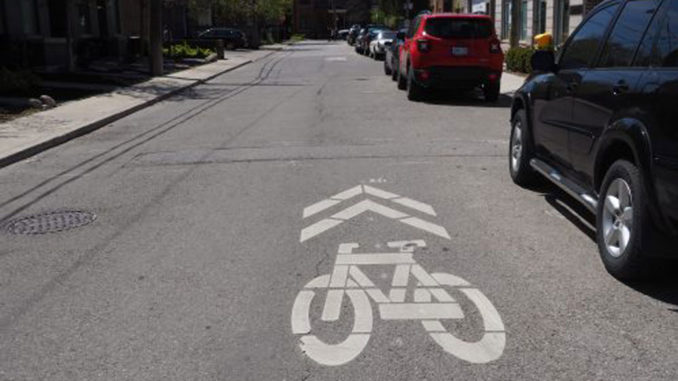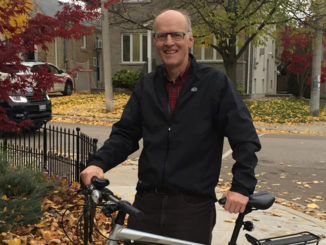
What happens when you come upon a cyclist on the road ahead? Do you slow down to assess the situation and then proceed with caution? Or do you dash ahead, accelerating to get past and on your way? Hopefully, you choose the first option and, thankfully, that is what many drivers do. Getting more people riding bikes on our streets is one way to help reduce vehicle speeds. As Dan Clement, acting manager of traffic operations transportation services, North York district, notes, “Cycling and traffic calming can complement each other.”
Narrowing the roadways
Wide-open, straight roads signal to drivers that speeding is safe. In Ontario, cyclists are expected to ride about one metre from the curb or parked cars, more if needed for safety. And by law, drivers are required to leave at least one metre between their vehicle and the person on a bike when passing. That is at least two metres of road narrowing right there. Add in space for on-street parking and a street may no longer be attractive for those who want to speed through our neighbourhood. Painted bike lanes and sharrows (shared lane markings) indicate to drivers that they can expect to encounter cyclists on route, and sharrows are well suited to the Leaside environment. But Shawn Dillon, manager of cycling infrastructure & programs, at the City of Toronto, explains that sharrows alone will not reduce vehicle speeds. It’s the presence of cyclists on the roadway that creates the perception that lower speeds are needed.
More trips under 5 km by bike
According to a 2016 study by Ryerson University’s TransForm Lab, about one-third of car trips in Toronto are potentially cyclable. These are trips of 5 km or less – to school, work and transit, and for errands and other outings. If people were making more of these trips by bike, that’s fewer cars on our roads, reducing congestion and improving air quality. Where would you cycle in Leaside if you felt safe doing so? And what would it take to make you feel safe?
Lower posted speed limits
If we want to lower posted speed limits in Leaside, having cycling infrastructure on our streets can help. According to the City’s Traffic Calming Guide for Toronto, either a signed shared roadway (such as Broadway), or the presence of sharrows or a contra-flow bike lane on a one-way street, along with a petition from 25 per cent of residents, will get the ball rolling (although the North York Community Council has the final say).
The measures proposed in the Leaside Property Owners Association’s Traffic Calming Plan can work hand-in-hand with increased cycling to reduce vehicle speed and traffic in our neighbourhood. Cycle Don Valley Midtown is looking at how to take advantage of cycling infrastructure to create safe and connected routes where Leasiders want to ride.
Holly Reid is a recreational road rider and cycling commuter. An advocate for safe cycling, she is a member of Cycle Don Valley Midtown, Cycle Toronto’s advocacy group for Wards15/16.





